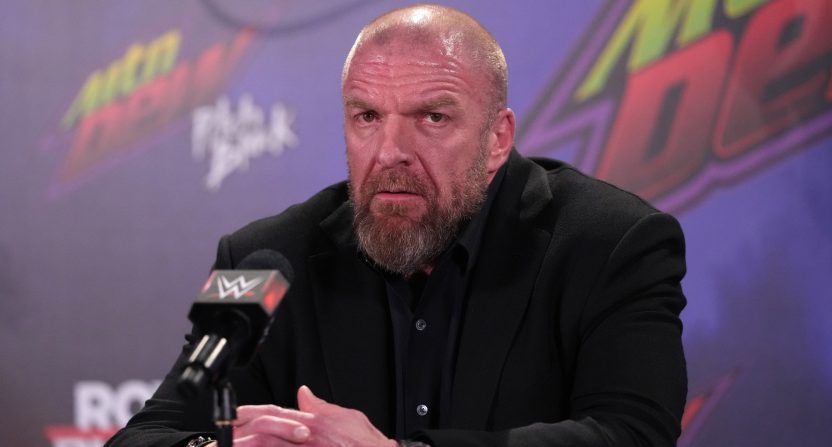In WWE lore, the demise of kayfabe — pro wrestling parlance for sticking to the storyline under any and all circumstances — first began on May 19, 1996.
At the conclusion of a main event steel cage match between Shawn Michaels and Kevin Nash at a house show at Madison Square Garden, the two wrestlers were joined in the ring by Scott Hall and Triple H. The four real-life best friends proceeded to engage in a post-match celebration, a shocking sight considering that Michaels and Hall were faces, while Nash and Triple H were heels.
Later dubbed the “Curtain Call,” the celebration served as a watershed moment for pro wrestling’s blurring of the line between fiction and reality. And with Hall and Nash on their way to rival promotion WCW and Michaels serving as the WWF champion, it was Triple H who took the brunt of the punishment from Vince McMahon, famously losing his spot as the eventual winner of the King of the Ring tournament to a promising up-and-comer named “Stone Cold” Steve Austin.
Nearly 30 years after taking the blame for not observing kayfabe, it appears that Triple H could now be taking a sledgehammer to it.
While WWE hasn’t been shy to occasionally peel back the curtain over the course of the last three decades, Netflix’s upcoming WWE: Unreal series promises to do so in an unprecedented manner. What appears to be WWE’s version of Drive to Survive will focus on the pro wrestling promotion’s writers’ room, giving viewers a never-before-seen look at the decision-making that ultimately shapes the company’s on-screen storylines.
That might seem strange considering the involvement of Triple H, who currently serves as WWE’s chief content officer under his government name of Paul Levesque. After all, it was just last week that the WWE Hall of Famer took issue with critics of his creative, urging them to “f**k off” and “be a fan,” while pining for the days where the audience was less clued in to the backstage happenings.
But in the very same interview with Peter Rosenberg (which was uploaded to WWE’s YouTube page), Levesque also explained that he sees a difference between spoiling an outcome beforehand and revealing how the company’s creative arrived at a decision after the fact.
“Ruining it happens before. Telling me after doesn’t ruin it; it tells me how it was made,” Levesque said. “There needs to be some distance, right? I don’t wanna see the blooper reel playing. And we’ve had challenges with this, even here. There’s some things that, they put an ad in the show, and I’m like, ‘take that ad out of the show. You can’t show me that in the show.’ Don’t show me how the wires are f***ed. Not during the show, not the second it ends.
“You want to show me next week, next month? Go ahead. You want to show me a couple of months down the line? Go ahead.”
Levesque proceeded to reflect on last year’s WrestleMania XL: Behind the Curtains feature, which he admitted was delayed as a result of “all the alternative versions of what actually happened and what didn’t happen.” And that raises perhaps the biggest question about WWE: Unreal: will it actually be a an unvarnished look at the company’s creative process? Or will it merely be the version of it that it wants us to see?
And also, how would we know either way?
“One thing about our business, it’s all believably unbelievable,” Levesque told Rosenberg.
Obviously, WWE isn’t going to make itself look bad in its only docuseries, but it will certainly be interesting to see how much of an inside look we actually get. Will we get legitimate insight into how the WWE creative process works on a micro level? Or will it come off as a WWE P.R. puff piece, especially with regard to Levesque’s role as the company’s head of creative?
The trailer looks promising, and also gives us an idea of the timeframe the series will cover. Most notably, the preview indicates that it will cover John Cena’s heel turn, which could also mean that it will include the lackluster WrestleMania 41 main event between Cena and Cody Rhodes.
How the series approaches such topics will tell us plenty, especially when factoring in The Rock’s temporary role. Will the series address any creative changes that may have happened between Cena’s heel turn and WrestleMania 41? Will it even acknowledge the overwhelming backlash to the WrestleMania main event?
We’ll find out this summer, but regardless of what the series shows (or doesn’t show), WWE: Untold possesses the potential to shatter kayfabe as we know it. Even if we’re learning how storylines were planned after the fact, the insight gained could go a long way toward shaping how fans consume the product moving forward.
That’s not necessarily a bad thing, just like “Curtain Call” proved to be such a pivotal moment in WWE’s history that the company now celebrates it publicly. Ultimately, straddling the line between fiction and reality has always been a big part of pro wrestling’s appeal. But while it’s one thing to do it in the squared circle, it’s another to do it in the writers’ room. And to that end, it will be worth monitoring whether the series continues to blur the lines or puts WWE’s creative process into clear view.
